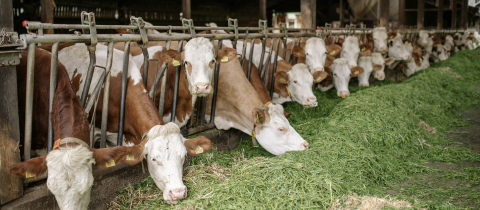We know what we should be doing if we want to be environmentally conscious. Recycle, compost, use public transport more, insulate better, shop with reusable bags. But here is something that is probably even more effective. Eat more vegetables and less meat. How can that have anything to do with the environment? Easy. Eating meat is a very inefficient way of consuming plant food. That of course is what it amounts to; animals eat plants and we eat them. Eating the plants directly has less of an impact on the environment since about two and a half pounds of grain are needed to produce a pound of meat. The extra grain needed to feed animals means more fertilizer used, more pesticides used, more transportation and more refrigeration. To clear land needed to raise animals and feed them often means that rainforests are destroyed. Then there is the problem of greenhouse emissions. Animals release methane both from their digestive tract and from their manure. Methane is a potent greenhouse gas. There is also the issue of nitrous oxide that is emitted from the ammonia based fertilizers used to grow feed. Cows and sheep are the biggest culprits, while pigs and chickens are not as bad when it comes to methane emission. Indeed some estimates suggest that livestock are responsible for as much as 18% of the greenhouse gases that cause global warming, more than cars, planes and all other forms of transport combined. And that estimate does not come from crazed vegetarian hippies, it comes from the Food and Agriculture Organization of the United Nations.
Here’s another interesting statistic. It takes about 54 calories worth of fossil fuel to produce 1 calorie worth of beef protein, while it takes only two calories of fossil fuel to produce one calorie worth of soy protein. And animals also require water, as do the crops that feed them. As well, huge amounts of water are used in meat processing. It takes over 20,000 liters of water to produce a pound of meat, which is roughly what a person uses in a year’s worth of showers. Only 200 liters are needed to grow a pound of apples, and half that for a pound of tomatoes. When it comes to feeding the world’s growing population, meat isn’t the answer. For example, the same amount of land that would meet the caloric needs of one person if used to produce beef, would provide for the needs of 23 people if used to grow cabbage. Of course most people would rather eat beef than cabbage and the developing world is rapidly developing an appetite for meat. Of course, as expected, the beef industry trots out its own statistics to show that most of the allegations about meat being an environmental disaster are just myths. They explain that animals eat the leftovers of other industries. For example, the soy that is fed to cattle is made from the remnants of the beans after they have been processed to extract the soy oil and that the corn fed to animals is specially grown for livestock feed and is of lower consumption than that grown for human use. Actually, most soy is grown specifically for feed and the land used to grow corn for animals could be better used to grow food directly for humans. None of this, nor the impressive health benefits of a vegetarian diet, have convinced me to give up meat. It just tastes too good. But I have made a point of having two meat free days a week. If everyone in North America did that, there would be a significant environmental benefit.







